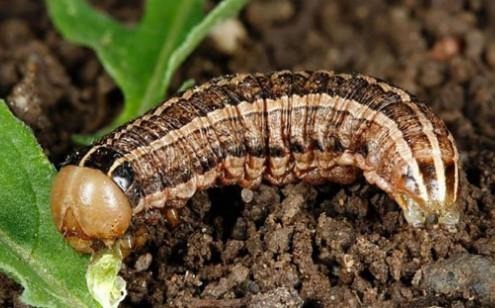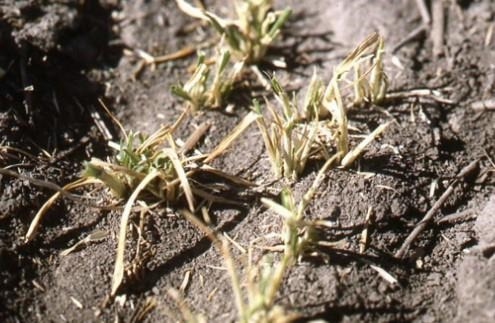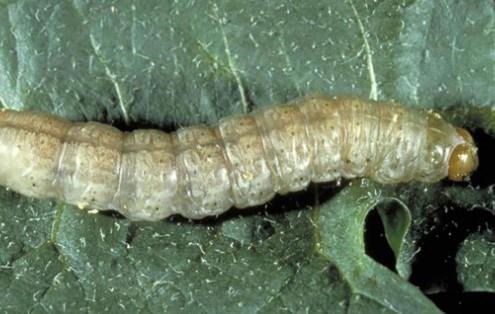By Adam Varenhorst
It is finally warming up in South Dakota, and that means that insect activity in wheat fields will be increasing. For wheat, a couple of early-season pests that may already be active are the army cutworm (Figure 1) and the pale western cutworm (Figure 3). These cutworms can cause economic injury to wheat when large populations are present within a field.
Army Cutworm

Figure 1. Army cutworm caterpillar. Courtesy: Joseph Berger, Bugwood.org.
The army cutworm (Figure 1) overwinters as a caterpillar in winter wheat fields, which is why it is often one of the first pests observed in the crop. Young caterpillars are small and generally a light, green-brown color with relatively few markings. As the caterpillars mature, they develop a dull-gray or gray-brown body that may have mottling (spots or smears of varying colors). Older caterpillars will have several pale stripes that run the length of their bodies. Regardless of age, the caterpillars have a light-brown head.
Army cutworm caterpillars feed at night and hide just below the soil surface during the day. Scouting for the caterpillars can be time-intensive due to sampling soil, thus management decisions based on detection and characteristic plant injury are recommended.

Figure 2. Wheat injured by cutworm feeding. Courtesy: R. J. Bauernfeind.
The feeding is characterized as “clipping” where the caterpillars feed on the plant near the soil surface. This type of feeding can result in patches of plants that appear to be cut or clipped (Figure 2). For winter wheat, the caterpillars tend to feed on the tender blades. Army cutworms generally do not feed on the stem, crown or meristematic tissues, which allows plant regrowth to occur.
In areas where caterpillars are abundant, they will move from food-source to food-source in mass, or “army style.” Management is recommended if patches of the field have been defoliated, or if two-to-four army cutworm caterpillars are observed per one square foot.
Pale Western Cutworm

Figure 3. Pale western cutworm caterpillar. Courtesy: John Capinera, Bugwood.org.
As indicated by its name, pale western cutworm caterpillars have light, gray-white-colored bodies (Figure 3). The heads of the pale western caterpillars range from light-to-dark brown but will always have two distinct vertical lines. The caterpillars also have characteristic dark spots on each body segment. The pale western cutworms overwinter as eggs and hatch in the spring when temperatures are favorable.
Pale western cutworm caterpillars feed on plants below the soil surface, which causes the plant to die. They are not usually observed feeding on plants until later in the spring and are sometimes more of a pest in spring wheat. However, they can be an occasional pest of winter wheat if the weather permits. Management is recommended if one-to-two pale western cutworm caterpillars are observed per one square foot.
Management
If management of either species of cutworm is necessary, an insecticide application is recommended. Please refer to the latest South Dakota Pest Management Guide - Wheat for a list of products labeled for cutworm management.
Source : sdstate.edu